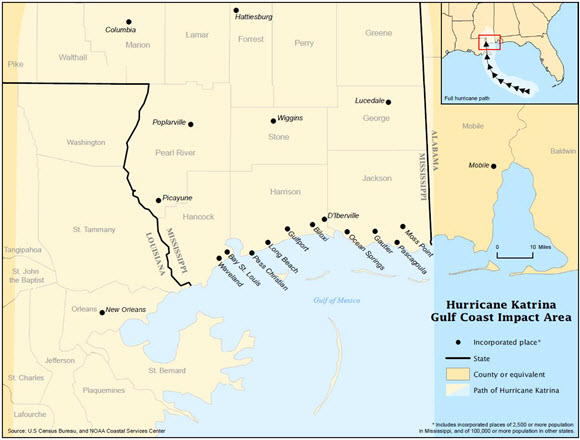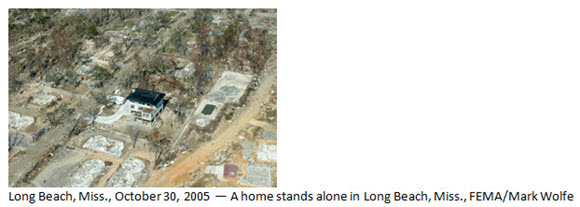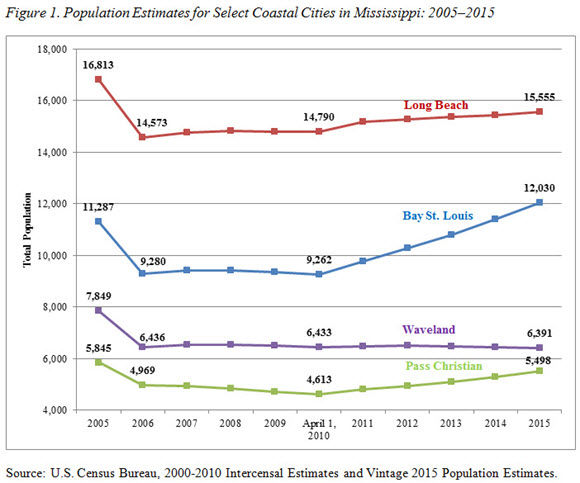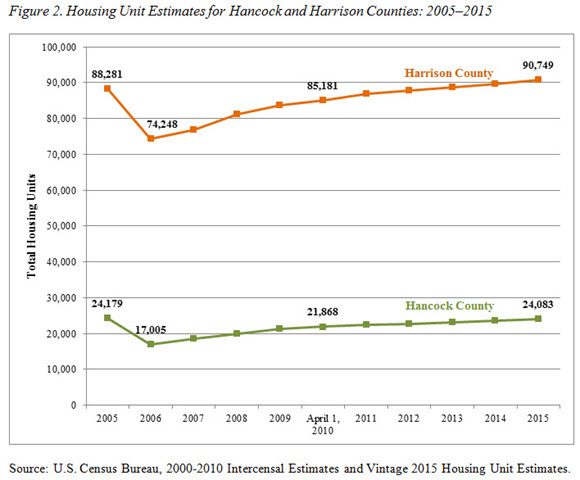After Hurricane Katrina: Where Are They Now?
After Hurricane Katrina: Where Are They Now?
Population and housing estimates from last decade show how Hurricane Katrina affected Gulf Region
As you might know, we released the population estimates for cities and towns last week. However, following Hurricane Katrina in August 2005, the U.S. Census Bureau did not release these estimates for four Mississippi Gulf Coast communities— Bay St. Louis, Long Beach, Pass Christian and Waveland in 2006. The cities sustained severe damage from Katrina, and the impact to their populations and housing stock could not be reliably measured.
In the aftermath of the storm, the Gulf Coast would face many years of rebuilding, and learning how populations were rebounding would be critical for community leaders. For the Census Bureau, producing population estimates for places where many homes had been destroyed and people displaced presented a unique but vital challenge.
Between 2006 and 2009, the Census Bureau used a variety of methods and data sources, including data from the U.S. Postal Service, to estimate the impact to the population and housing stock in the counties and parishes hit hardest by the hurricane.
In 2008, we used the number of active utility connections to produce a complete time series of housing and population estimates for these cities, going back to 2006. By 2009, the Census Bureau had resumed the pre-2006 methods for estimating housing units and populations for almost all cities and towns across the country. We estimated 2006 county and parish housing units in Orleans and St. Bernard parishes by first calculating the ratio of the 2006 household population to the 2005 household population. We applied the ratio to the 2005 county housing unit estimate to produce the 2006 estimated housing.
The population and housing unit estimates produced last decade, along with the 2010 Census counts and the 2015 estimates released today, provide a basis for understanding how Hurricane Katrina affected the Gulf Coast, and in particular the four Mississippi cities discussed in this blog.
Population
Bay St. Louis — On July 1, 2005, the population stood at 11,287. Just one year later, it had declined by more than 2,000 people, or about 18 percent. Its population remained flat through 2010 but recovered over the next five years, increasing by about 2,800 (30 percent) to 12,030, or about 700 more people than in July 2005, before Hurricane Katrina. Of the four cities we looked at, it was the only one to surpass its pre-Katrina population.
Long Beach — Prior to Hurricane Katrina, Long Beach numbered 16,855, making it the largest of the four cities in terms of population. It also had the largest numeric loss after the storm. By July 1, 2006, its population had dropped by a little more than 2,200 (13 percent). By 2010, the city’s population had recovered to 14,790, or approximately 88 percent of its population before the hurricane. Like Bay St. Louis, the city of Long Beach saw its population increase from 2010 to 2015. Ten years after the hurricane, the city remained about 1,300 people shy of its pre-Katrina population with a population of 15,555.
Pass Christian — About a year after the hurricane, Pass Christian’s population had dropped 15 percent from its pre-Katrina estimate of 5,845, putting it just under 5,000 people. Its population continued to decline until 2010, when it reached a low of 4,613. From that point forward, however, the trend reversed and on July 1, 2015, the population estimate reached 94 percent of its pre-Katrina level.
Waveland — Of these four Gulf Coast communities, Waveland had the largest percent decrease in population in the year after Hurricane Katrina. On July 1, 2005, Waveland’s population was 7,849. A year later its population had declined by 18 percent and would remain mostly unchanged over the next four years. Between 2010 and 2015, the city’s population declined by another 40 people. Its population on July 1, 2015, was at about 82 percent of its population 10 years earlier.
Housing Units
Every year, the Census Bureau releases population estimates for cities and towns across the country, and housing unit estimates for the nation, states, and counties. Of the four cities discussed previously, Bay St. Louis and Waveland are in Hancock County. Long Beach and Pass Christian are in Harrison County.
Hancock County — On July 1, 2005, Hancock County had 24,179 housing units. About one year after Katrina, it declined by about 7,000 housing units, or 30 percent of its housing stock. By 2010, the housing stock had returned to approximately 90 percent of its pre-Katrina level. As of July 1, 2015, Hancock County was back up to 24,083 housing units, a mere 96 shy of where it stood 10 years earlier.
Harrison County — On July 1, 2005, Harrison County had 88,281 housing units, nearly four times as many as Hancock County. Almost a year after Hurricane Katrina, Harrison County’s housing stock decreased by more than 14,000 housing units, or about 16 percent of its housing estimate before the hurricane. Between July 1, 2006, and April 1, 2010, the reference day for the 2010 Census, almost 11,000 housing units were added, an increase of about 15 percent. By July 1, 2015, it had 90,749 housing units, about 2,500 more than it had 10 years earlier.
These estimates reflect several years of special processing to produce a time series that accurately reflects the impact Hurricane Katrina had on these communities.
If you would like to continue to explore these estimates, or examine other population trends in the United States, please go to<www.census.gov/programs-surveys/popest.html>. You may also wish to contact the State Data Center of Mississippi for their perspectives on the population and housing trends highlighted here. To learn more about the characteristics in these areas, check out data from the American Community Survey and economic data.









